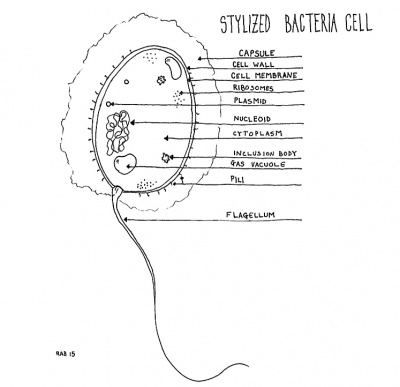Difference between revisions of "AY Honors/Bacteria/Answer Key"
| Line 25: | Line 25: | ||
==2. Through drawings or pictures, identify the main structures of the bacterial cell.== <!--T:3--> | ==2. Through drawings or pictures, identify the main structures of the bacterial cell.== <!--T:3--> | ||
| + | |||
| + | [[Image:BacteriaCell.jpg|400px]] | ||
| + | |||
| + | Some structures of bacteria | ||
| + | |||
| + | '''Capsule''' (Slime Layer): Provides protection, as well as may serve for adhesion (sticking the cell to something) | ||
| + | |||
| + | '''Cell Wall''': Provides form, structure and protection. There are two different basic structures of cell walls in Bacteria. One is a cell wall made of a relatively thick layer of Peptidoglycan (carbohydrates and proteins). The other has an additional outer layer that includes carbohydrates, proteins and lipids (fats). | ||
| + | |||
| + | '''Cell Membrane''': The boundary of the cell, selectively permeable to allow certain molecules and gasses to pass through. | ||
| + | |||
| + | '''Ribosome''': The organelle responsible for protein synthesis | ||
| + | |||
| + | '''Plasmid''': A ring of genetic material separate from that within the nucleoid | ||
| + | |||
| + | '''Nucleoid''': The location of the genetic material of a bacteria | ||
| + | |||
| + | '''Cytoplasm''': The “goo” inside the cell, in which the organelles and all other content exist. | ||
| + | |||
| + | '''Inclusion Body''': Non-membranous granules in the cytoplasm used to store materials | ||
| + | |||
| + | '''Gas Vacuole''': In some water-borne bacteria, small gas filled pockets used for bouyancy | ||
| + | |||
| + | '''Pili''': microscopic tubes on some bacteria, used for attachment, or as a way to connect two bacteria to transfer genetic material | ||
| + | |||
| + | '''Flagellum''': A hair- or whip-like appendage, used for motility | ||
| + | |||
| + | '''Endospore''': A hard-cased spore produced by a bacteria often to assist in survival of hostile environment. | ||
==3. Draw the four main forms of bacteria.== <!--T:4--> | ==3. Draw the four main forms of bacteria.== <!--T:4--> | ||
Revision as of 02:14, 28 March 2015
1. What are the main characteristics of bacteria that distinguish them from other living beings?
Bacteria are single cell organisms (though some do form chains or other colonial groupings, each individual remains its own organism).
The have no membrane around their internal organelles - so rather than a nucleus containing genetic material, which has its own membrane keeping it separate from the rest of the cell contents, bacteria have a nucleoid, without a distinct membrane.
All but one group of bacteria have both a cell membrane and a cell wall.
The genetic material in a Bacteria is in a tangled loop in the nucleoid
Many bacteria also have loops of genetic material, called Plasmids, that can serve to transfer genetic information between organisms, and may provide new or useful characteristics for a bacteria, which in part explains why they are able to adapt so quickly as species.
2. Through drawings or pictures, identify the main structures of the bacterial cell.
Some structures of bacteria
Capsule (Slime Layer): Provides protection, as well as may serve for adhesion (sticking the cell to something)
Cell Wall: Provides form, structure and protection. There are two different basic structures of cell walls in Bacteria. One is a cell wall made of a relatively thick layer of Peptidoglycan (carbohydrates and proteins). The other has an additional outer layer that includes carbohydrates, proteins and lipids (fats).
Cell Membrane: The boundary of the cell, selectively permeable to allow certain molecules and gasses to pass through.
Ribosome: The organelle responsible for protein synthesis
Plasmid: A ring of genetic material separate from that within the nucleoid
Nucleoid: The location of the genetic material of a bacteria
Cytoplasm: The “goo” inside the cell, in which the organelles and all other content exist.
Inclusion Body: Non-membranous granules in the cytoplasm used to store materials
Gas Vacuole: In some water-borne bacteria, small gas filled pockets used for bouyancy
Pili: microscopic tubes on some bacteria, used for attachment, or as a way to connect two bacteria to transfer genetic material
Flagellum: A hair- or whip-like appendage, used for motility
Endospore: A hard-cased spore produced by a bacteria often to assist in survival of hostile environment.

